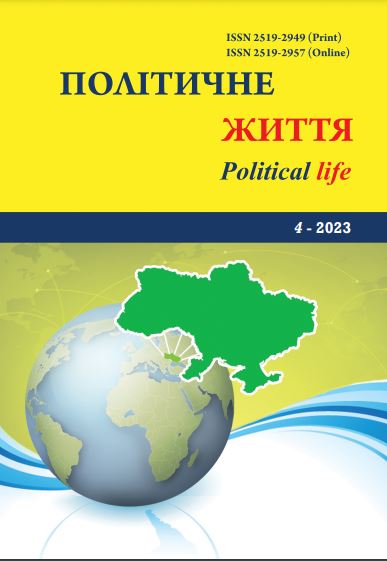Planning of measures for the implementation of humanitarian policy
DOI:
https://doi.org/10.31558/2519-2949.2023.4.10Keywords:
humanitarian policy; humanitarian sphere; mass culture; planning; strategic planning; strategic communicationsAbstract
The article analyzes the features of the organization of planning measures for the implementation of humanitarian policy as a strategically important task and one of the key prerequisites for sustainable development of the country. The state humanitarian policy is considered as the main factor in the legitimation of public power and the consolidation of the state and civil society.
It is proved that the effective functioning of the humanitarian sphere of the State requires the use of advanced technologies for planning management processes and should take into account the goals, principles, mechanisms and specific measures aimed at creating conditions for the full humanitarian development of society, revealing and enriching its intellectual potential, ensuring the comprehensive spiritual and creative realization of the individual and the necessary sociodynamics of education, science, art, literature and others components of spiritual life.
The key tools for strategic planning of humanitarian policy are outlined, which include complex process, partially process and substantive tools, as well as systematic approaches to planning measures for the implementation of humanitarian policy.
A promising concept of planning measures for the implementation of humanitarian policy, quality control tools and risk management methods in the context of planning measures for the implementation of humanitarian policy is proposed.
It is determined that to assess the effectiveness of planning measures for the implementation of humanitarian policy, you can use such methods as the rank method, matrix methods, STEP-analysis, SWOT-analysis, SPACE-analysis, GAR-analysis, LOTS-analysis, RIMS-analysis, etc. In turn, risk identification can be carried out both according to the cause-effect scheme (what can happen and what it will lead to) and according to the consequence-cause scheme (what consequences should be avoided and, on the contrary, aspired to, what events these consequences can cause).
It is summarized that effective planning of measures for the implementation of humanitarian policy contributes to the achievement of consensus between various social forces and interests, ensuring the democratic consolidation of society, its development within the basic values of national security of the State.
References
Розпорядження Кабінету Міністрів України від 06 грудня 2017 р. № 878-р. «Про затвердження плану заходів щодо виконання Концепції реалізації державної політики у сфері зміни клімату на період до 2030 року». URL: https://ips.ligazakon.net/document/kr170878?an=1 (дата звернення: 14.12.2023).
Розпорядження Кабінету Міністрів України від 01 липня 2020 р. № 853-р. «Про затвердження плану заходів з виконання Концепції реалізації державної політики у сфері сприяння розвитку соціально відповідального бізнесу в Україні на період до 2030 року». URL: https://www.kmu.gov.ua/npas/pro-zatverdzhennya-planu-zahodiv-z-vikonannya-koncepciyi-realizaciyi-derzhavnoyi-politiki-u-sferi-t10720 (дата звернення: 14.12.2023).
Розпорядження Кабінету Міністрів України від 27 грудня 2019 р. № 1422-р. «Про затвердження плану заходів із впровадження Концепції реалізації державної політики у сфері промислового забруднення». URL: https://ips.ligazakon.net/document/KR191422 (дата звернення: 14.12.2023).
Розпорядження Кабінету Міністрів України від 07 липня 2023 р. № 607-р. «Про затвердження плану заходів з реалізації кліматичної політики України в рамках участі в глобальній ініціативі із скорочення викидів метану «Global Methane Pledge». URL: https://www.kmu.gov.ua/npas/pro-zatverdzhennia-planu-zakhodiv-z-realizatsii-klimatychnoi-polityky-ukrainy-v-ramkakh-uchasti-v-hlobalnii-initsiatyvi-iz-skorochennia-vykydiv-metanu-global-methane-pledge-i070723-607 (дата звернення: 14.12.2023).
Оніщенко Н. М., Стоєцький С. В., Сунєгін С. О. До питання про відповідальність держави перед громадянським суспільством. Часопис Київського університету права. 2014. № 2. С. 9-13.
Конопелько О. В. Особливості формування ідеологічної функції сучасної держави: постановка проблеми. Право і безпека. 2013. № 1. С 18-23.
Мовчан У. В. Методологічні підходи до здійснення стратегічного планування політико-правового розвитку держави. Актуальні проблеми політики. 2022. Вип. 69. DOI: https://doi.org/10.32837/app.v0i69.1299 (дата звернення: 15.12.2023).
Mishra S., Mohanty B. Approaches to strategy formulations: A content analysis of definitions of strategy. Journal of Management & Organization. 2020. Рp. 1-28.
A Guide to the Project Management Body of Knowledge PMBOK 6th Edition. URL: https://vuthedudotorg.files.wordpress.com/2019/11/a-guide-to-the-pmbok-6e.pdf (дата звернення: 15.12.2023).
Блага Н. В. Управління проєктами. Львів : Львівський державний університет внутрішніх справ, 2021. 152 с.
Kümmerle R., Grisetti G., Strasdat H., Konolige K., Burgard W. A general framework for graph optimization. International Conference on Robotics and Automation. 2011. May. Pp. 3607-3613.
Шипілова Л. М., Марутян Р. Р. Аналітичні засоби стратегічного планування забезпечення національної безпеки в умовах глобальних загроз національній безпеці та міжнародній стабільності. Збірник наукових праць Національної академії державного управління при Президентові України. 2017. №2. С. 88-104.

